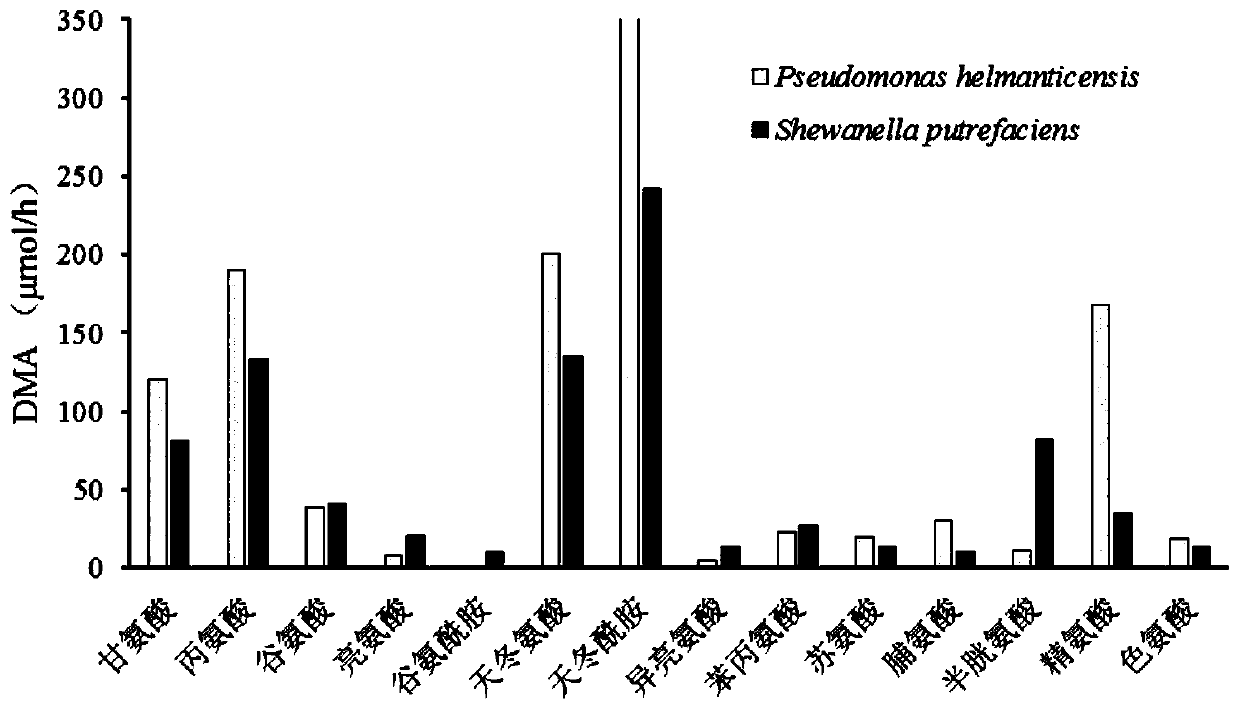Method for detecting deamination capability of amino acid of spoilage bacteria in fish flesh
A detection method, amino acid technology, applied in the direction of microorganism-based methods, biochemical equipment and methods, microorganism measurement/inspection, etc., can solve the evaluation method of amino acid deamination ability of fish spoilage bacteria, bad flavor, reduce The commercial value of fish meat and other issues
- Summary
- Abstract
- Description
- Claims
- Application Information
AI Technical Summary
Problems solved by technology
Method used
Image
Examples
Embodiment 1
[0039] Example 1 Detection of Amino Acid Deamination Ability of Specific Putrefaction Bacteria Pseudomonas helmanticensis in Refrigerated Bighead Carp Meat
[0040] Specifically include the following steps:
[0041] (1) Preparation of microbial suspension: Pick a single colony of isolated and purified Pseudomonas helmanticensis in tryptone soybean broth, culture in a shake flask in a water bath at 30°C until the total number of colonies in the broth reaches 9.0 log CFU / mL, and use sterile physiological Adjust the concentration of the bacterial suspension with saline to 8.0log CFU / mL for later use.
[0042] (2) Preparation of amino acid substrate solution: Dissolve the glycine substrate in 0.045M, pH=7.50 phosphate buffered saline (PBS), so that the glycine concentration is 5.0mM; the solution is sterilized at 121°C for 15min, and then added after cooling Oxidized nicotinamide adenine dinucleotide (NAD + ), so that NAD + The final concentration is 0.07mM, namely the substrat...
Embodiment 2
[0066] Example 2 Detection of Amino Acid Deamination Ability of Specific Putrefaction Bacteria Shewanella putrefaciens in Refrigerated Silver Carp Meat
[0067] Specifically include the following steps:
[0068] (1) Preparation of microbial suspension: Pick a single colony of isolated and purified Shewanella putrefaciens in tryptone soybean broth, culture in a shake flask in a water bath at 30°C until the total number of colonies in the broth reaches 9.0log CFU / mL, and use sterile physiological Adjust the concentration of the bacterial suspension with saline to 8.0log CFU / mL for later use.
[0069] (2) Preparation of amino acid substrate solution: Dissolve the glycine substrate in 0.045M phosphate buffered saline (PBS), pH=7.50, so that the concentration of glycine is 5.0mM; the solution is sterilized at 121°C for 15min, and then added after cooling Oxidized nicotinamide adenine dinucleotide (NAD + ), so that NAD + The final concentration is 0.07mM, namely the substrate sol...
PUM
 Login to View More
Login to View More Abstract
Description
Claims
Application Information
 Login to View More
Login to View More - R&D
- Intellectual Property
- Life Sciences
- Materials
- Tech Scout
- Unparalleled Data Quality
- Higher Quality Content
- 60% Fewer Hallucinations
Browse by: Latest US Patents, China's latest patents, Technical Efficacy Thesaurus, Application Domain, Technology Topic, Popular Technical Reports.
© 2025 PatSnap. All rights reserved.Legal|Privacy policy|Modern Slavery Act Transparency Statement|Sitemap|About US| Contact US: help@patsnap.com



